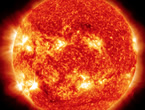Introduction
The Sun shines, but why and for how long? Our understanding of the Sun fell short when it came to explaining the energy powering it. Then, along came Einstein. His work helped to explain our Sun and all the stars of the Universe.
More about this lesson
This lesson is intended to help interested students and teachers explore the science of Big History a little more deeply. Note that it is not part of the standard BHP course plan, and will be most helpful for those teaching or learning BHP with a focus on science.
Solar Phenomena
Preparation


Purpose
In this quick opening, you’ll put what you already know about the Sun to work. You might recognize some of the features in this activity, and others might be less familiar to you. Throughout this lesson, you’ll learn more about the features covered in this activity, so it isn’t important that you correctly name all of the features in this exercise—just take your best guess.
Process
Use the Solar Phenomena Worksheet to match the images with the list of solar phenomena. This activity is an opportunity for you to start thinking about some of the features of the Sun, and begin asking your own questions about these phenomena.
How Do We Know How Old the Sun Is?
Preparation
Please click here to watch this video. Note that this will take you off the BHP site.
Summary
Einstein’s equation explains that a small amount of mass is equivalent to a tremendous amount of energy. By measuring the amount of energy that reaches Earth and knowing the Earth’s distance from the Sun, scientists were able to determine the mass of the Sun. From this calculation, they estimate that the Sun will continue to burn its hydrogen fuel for another 5 billion years.
Preparation
This video will give you an overview of some basic information about the Sun, including its age, its temperature, the energy it creates through nuclear fusion, and how long we expect it to continue burning its fuel.
Process
Preview
In 1905, Albert Einstein published the famous equation E=mc², revealing the relationship between mass and energy. This breakthrough allowed scientists to calculate the mass of the Sun and estimate how much longer it will burn as the bright center of our Solar System. Interestingly, in that same year, Ernest Rutherford invented radiometric dating. Rutherford’s work, including discovering the concept of radioactive half-life, paved the way for the radiometric dating of rubidium, allowing us to calculate the age of the Sun.
Key Ideas—Factual
Think about the following questions as you watch the video:
- What can we find out from studying meteorites?
- What formed at the same time as the meteorites that land on Earth?
- How old is the Sun, according to rubidium dating?
- What happens in the Sun’s core?
- How far away is the Earth from the Sun?
- What can we calculate from measuring how much energy falls on the Earth from the Sun?
- How much longer will the Sun continue to burn its fuel?
“Why Does the Sun Shine?”
Preparation


Summary
The Sun is powered by hydrogen, which is the simplest element known, with only one proton and one electron. But when heated to tremendous temperatures at an extreme density, as it is in the Sun’s core, this simple element undergoes a sophisticated transformation. Nuclear fusion bonds hydrogen atoms together, releases energy, creates helium, and pushes against the gravitational force. In 5 billion years, when the Sun has burned through its hydrogen, it will become a red giant and its helium core will produce heavier elements.
Purpose
This article will give you some basic information about the chemistry happening inside of the Sun. The Sun’s fuel is hydrogen, and the energy released when these atoms are fused together is the secret to the sunshine that powers life on Earth.
Process
Skimming for Gist
Hydrogen atoms are made up of single protons, which are positively charged and naturally repel each other. The heat and density of the Sun sets the stage for nuclear fusion of hydrogen atoms, where four hydrogen atoms are needed to create helium. Some of the energy released in this process is gamma rays, which take millions of years to reach the surface of the Sun. Once it converts all of its hydrogen fuel into helium, our Sun will expand as a red giant and begin crushing its helium into carbon, oxygen, and neon. But that won’t happen for another 5 billion years.
Understanding Content
By the end of the second close read, you should be able to answer the following questions:
- How much power does the Sun generate?
- What are the nuclei of atoms made up of?
- What kind of charge do protons have?
- What kinds of conditions are necessary in order to fuse lighter atoms into heavier atoms?
- How do hydrogen protons overcome their mutual repulsion?
- How many hydrogen protons are needed to form a helium atom?
- What elements will our Sun produce when it becomes a red giant?
- What elements are created by the most massive stars?
- Where are the rest of the elements in the Universe created?
Thinking Conceptually
The process of fusion in the Sun’s core gives off gamma ray photons, which can take millions of years to make it through to the surface of the sun. During that time, the photons continue to collide with matter inside the Sun, diffusing it gradually until it reaches the surface and “shines” as millions of visible wavelength photons. Does this journey of photons from the core to the surface of the Sun change the way you think about sunshine?
Crash Course Astronomy: The Sun
Summary
When we think about hydrogen, we typically picture it as a gas. But the heat and pressure in the Sun’s core ionizes the hydrogen, freeing electrons from their hydrogen nuclei. Hydrogen in the Sun is plasma, the fourth state of matter. Plasma can churn and flow like liquid, and the convection currents moving from the Sun’s core to the surface, paired with the Sun’s rotation, causes magnetic fields. These fields create storms, which blast material out from the Sun and can interfere with our magnetic field, resulting in beautifully glowing night skies—or threatening life as we know it.
The Sun: Crash Course Astronomy #10 (12:01)
Key Ideas
Purpose
This video provides you with more information about the Sun, including its layers, plasma, magnetic fields, and sunspots. The video also introduces you to the stormy conditions on the Sun’s surface, and you’ll learn how solar flares and coronal mass ejections can affect life on Earth.
Process
Preview
In 1998, the rock band They Might Be Giants covered a song called “Why Does the Sun Shine?,” which was originally written by another artist in 1959. According to the lyrics in that song, “The Sun is a mass of incandescent gas, a gigantic nuclear furnace/Where hydrogen is built into helium at a temperature of millions of degrees.”
In 2009, the band released another song called “Why Does the Sun Really Shine?.” Members of the band said that they wanted to make up for the incorrect information stated in the first song, and to give listeners some updated information about the Sun. Some lyrics from the newer song go, “The Sun is a miasma of incandescent plasma/The Sun’s not simply made out of gas… Plasma/Fourth state of matter/Not gas, not liquid, not solid/Plasma/Forget that song/Plasma/They got it wrong.”
Key Ideas—Factual
Think about the following questions as you watch the video:
- Why isn’t it quite accurate to say that our Sun is an “average” star?
- What are some ways to think about the size and mass of the Sun?
- What equation states how mass and energy can be converted into one another?
- What type of heat transfer brings heat from the core to the surface of the Sun?
- What layer of the Sun are we seeing when we see it shining?
- The Sun’s corona is much hotter than the photosphere and extends for millions of kilometers, so why can’t we easily see it without a total eclipse?
- What is the solar wind?
- Some calculations say it takes light millions of years to work its way out of the Sun, while other calculations say it takes two hundred thousand years. What is happening to those photons of energy after they are created during nuclear fusion, but before they are released as visible light?
- What is created by the charged particles of plasma moving inside the Sun?
- What causes sunspots?
- What protects the Earth from the Sun’s projected debris, the result of solar flares and coronal mass ejections?
- What caused the 1989 blackout in Montreal?
Thinking Conceptually
What do you think are some important reasons to study the Sun?Plasma Party
Preparation


Purpose
This activity will give you a more personal perspective on hydrogen fusion. You’ll act out the process of nuclear fusion that happens in the Sun’s core. You’ll demonstrate that it takes six hydrogen nuclei to fuse into a helium nucleus.
Process
Get into a group of six. Together, you’ll write and act out a short skit to illustrate how hydrogen nuclei become helium nuclei through fusion. Note that members of your group will need to play multiple roles in the skit, as the subatomic particles transform into different characters during the fusion process.
Don’t forget: It takes six hydrogen nuclei to make a helium nucleus, so all six members of your group will enter the Plasma Party at the same time.
The scene takes place at the hottest party in town: The Sun’s Core. Our characters are:
- Hydrogen nuclei, which also go by the name proton. They are completely silent but fast moving. When they dance with another proton they like to hold hands or link arms.
- Deuterium nuclei, also known as heavy hydrogen or 2H. This pair talks loudly while dancing and remaining linked together. They are always looking for a single hydrogen nucleus to befriend.
- Helium-3 nuclei. These three stick close together and speak quickly in high, loud voices. When they decide to dance with another Helium-3, they say goodbye to one of their protons.
- Helium-4 nuclei or He-4 is a stable and quiet group that easily tires and just wants to find a place to rest.
Take no more than 10 minutes to write simple dialogue for your characters at the Plasma Party. Your group will have a chance to show the class your Plasma Party skit.
After your group acts out your skit, answer the following on your worksheets, and be prepared to discuss your answers with the class:
- Some of the characters were written to have louder or quieter voices. What does this have to do with the energy given off at each stage of the process of nuclear fusion?
- If the whole class went to the Plasma Party as hydrogen nuclei, how many groups of He-4 would be left at the end of the party?




